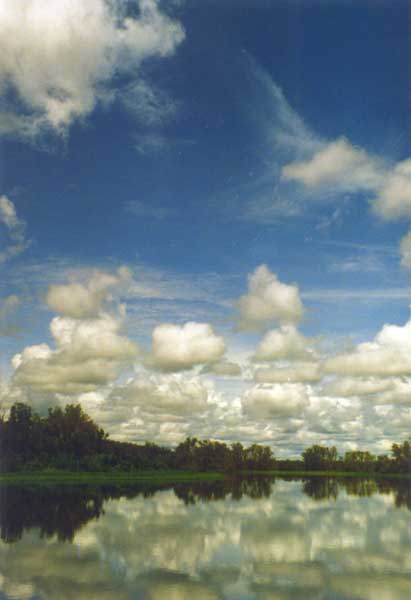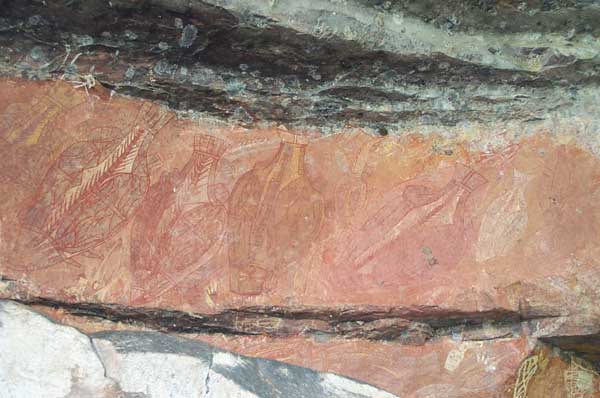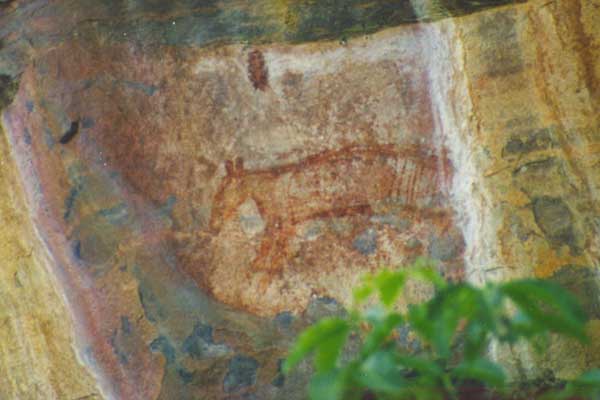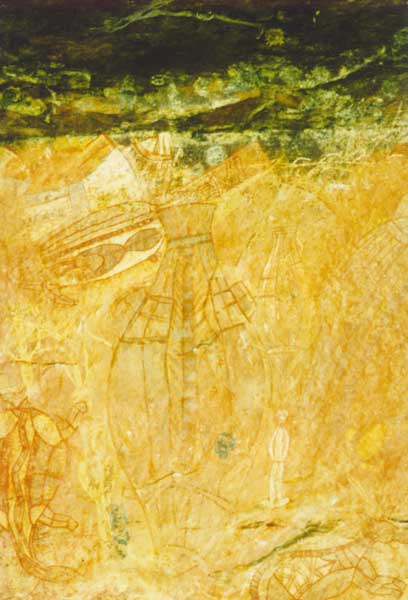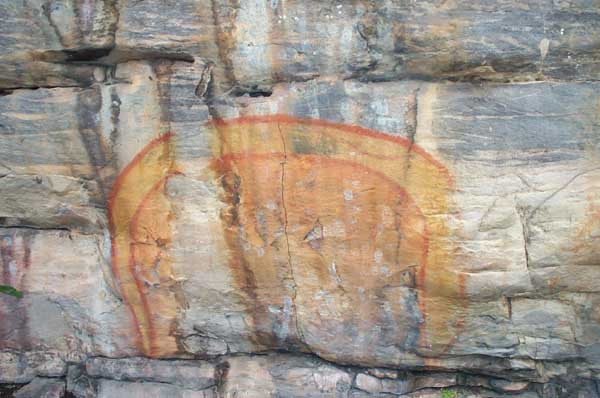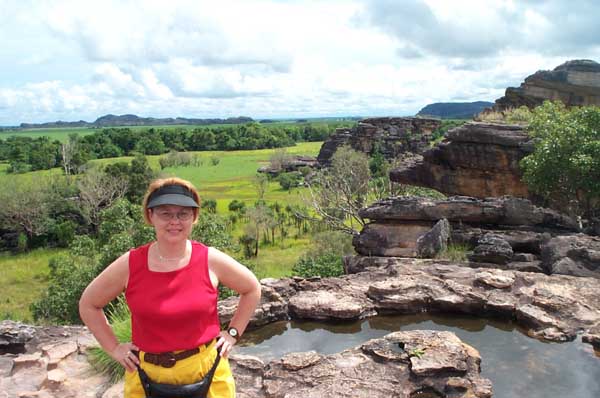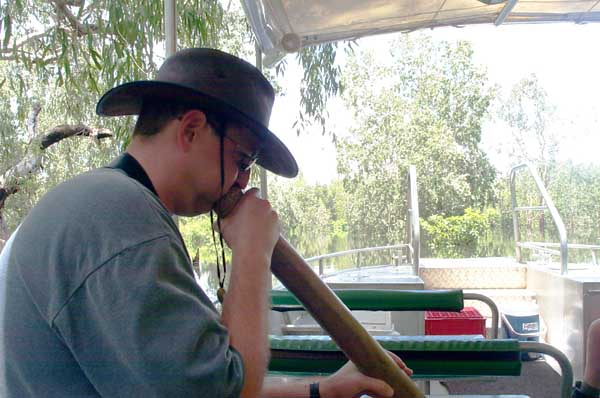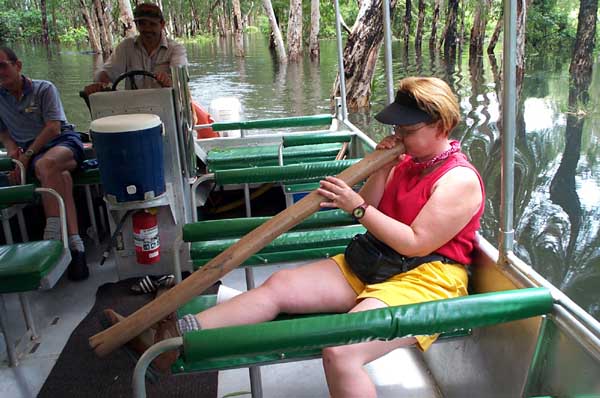We checked out of our hotel and waited for our 8:00 pick-up. When the bus arrived, we were surprised to see that it was still only the six of us from the previous day. The driver explained that he had started into the park on the Arnhem Highway the day before, believing that the flooding had subsided enough for him to get into the park that way. When he and his passengers reached the flooding, it turned out they couldn’t make it through. It was too late to retrace their route and come in the long way, so they had to turn around and return to Darwin. The bus driver then drove his empty bus in via the long route that evening so he could continue our tour.
Rather than stay in the bus that was really too big for six people, we transferred to a smaller bus and were on our way. We drove to Magela Creek, which, like every other creek, had overflowed its banks and was covering the road with more than a meter of water. We transferred to a pontoon boat, and Mick, the pilot, took us through the woods and along the creek to the point where the road once again emerged from the creek.
Mick is an Aborigine, so he took some time during our boat ride to tell us more about how the Aborigines use local plants. He pointed out several trees whose leaves are used for spices, one that houses a caterpillar that causes a bad rash, and gave us another demonstration of how paper bark is used. We passed a red-headed bird standing on some floating plants. Mick explained that the bird is called a Jesus Bird, because, as it walks across submerged plants, it appears to walk on water.
When we arrived back at the road, there was a group of people waiting to come back. They had spent the night in a campground near Ubirr, the area we were heading to. We left our boat and got into another bus that was waiting on that side of the creek. As we drove the remaining distance to Ubirr, we saw half a dozen wallabies along the road.
We reached Ubirr about 10:30, and it was already very hot and humid. It was well worth the hike around, though. The rock art in Ubirr doesn’t show the recent updates that were apparent at Nourlangie. The site “felt” more ancient and authentic.
One of the paintings depicts a Tasmanian tiger, a species that is now extinct. The last one died in Tasmania in the 1930’s, but they have been extinct in Kakadu for over 5000 years. The tiger in Ubirr was almost certainly painted before they became extinct there, making that particular painting over 5000 years old. Another painting is obviously more recent, since it depicts a white man. The man is literally painted in white and is wearing shoes.
There were lots of other rock paintings there, too. One of the paintings is called the “Rainbow Serpent,” a very important spirit in the creation myths of the Aborigines. According to their story, the Rainbow Serpent put all of the different clans in their various locations.
Because of this belief, the Aborigines have a very strong sense of belonging to a particular place. Each clan lives in, and takes care of their own territory. After creating all of the people, the Rainbow Serpent went underground and fell asleep. If anything disturbs her sleep, she causes storms and earthquakes.
In addition to the rock art, we saw a lots of local animals. There were a bunch of rock wallabies — little, dark kangaroos about the size of a fox. They mostly hid under rock overhangs, so it was very hard to get decent pictures of them.
There were also lizards, known as goannas to the Aborigines, sunning themselves on rocks. All of the animals were shy, not letting us get closer than twenty-five feet before disappearing into the rocks or bush.
A short hike up to the top of a rock outcropping brought us beautiful views of the plain that makes up the eastern border of Kakadu. Across that plain is Arnhem Land, Aboriginal land that begins at the Arnhem Land Escarpment. The escarpment is a wall of sheer sandstone cliffs that rise 300 to 900 feet above the plain. During the Wet, there are numerous waterfalls over the escarpment. We would get a closer look at them later in the day.
Most of the cultural significance of Kakadu is purely Aboriginal. However, there is a tidbit that influenced Western culture: The plain between Ubirr and Arnhem Land was used as a filming location for Crocodile Dundee. It was the land that Paul Hogan and Linda Kowalski trekked around in the Outback. In the movie Mick Dundee, Hogan’s character, referred to it as “Balongamik,” which he translated as “Mick’s Place.”
After admiring the scenery, then sitting in the shade a while to cool off, we returned to the bus, then back to the boat. On the trip back through Magela Creek, Mick showed us some Aboriginal spears. The shafts and spear heads were all made of wood. The heads were made of ironwood, a wood so hard that normal wood-working tools can’t cut it. They have to be cut with stones or, more recently, hacksaws. Once they are shaped, they can be sanded with the leaves of the sandpaper fig tree. The fishing spear is made of a very light wood. If you throw it and miss, it just bounces back out of the water, right back into your hand. If you hit a fish, you have to act fast to catch the spear before the fish swims off with it.
Mick also demonstrated a didgeridoo, the long, hollow, wooden tube used for ceremonial music. Real didgeridoos are made from branches that have been hollowed out by the world’s best carpenters, piping termites. They are painted, and the mouthpiece is coated with beeswax. Getting the traditional sound out of them is difficult. If you tighten your lips too much, it sounds like a trumpet. If you make them too loose, you just get a hiss. The trick is to make your lips flap together like horses do. This is difficult enough to do without a didgeridoo against your mouth. It’s even harder with one. Several of us were able to get the right sound out, but completely unable to control the pitch or anything else.
We made it the rest of the way through the creek, got back on our little bus, then drove to the Jabiru airport, a small strip where five of us had signed up for a one-hour scenic flight. It was still very hot, and the temperature in the Cessna 220 was over 100F when we climbed in. Before too long we were bounding down the runway and up in the air. This little, old plane was loud! However, we could hear the pilot over the intercom as he pointed out the local sights. We all had maps of the area with these sights identified, so we could follow our route. The plane didn’t get much cooler throughout the flight.
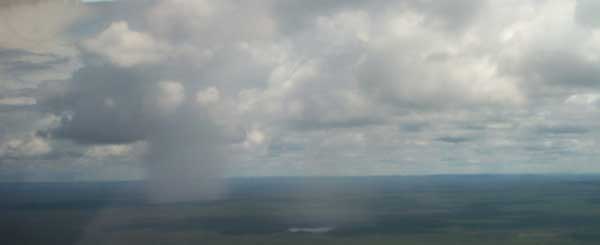
As we flew across the eastern Kakadu plain, towards the Arnhem Land Escarpment, we could see small rain squalls dampening the plain. We mostly flew between them, but had to fly through one or two to get to the main sights. They were bumpy.
The highlights of the trip were terrific views of both Jim Jim Falls and Twin Falls.
We also flew near Mt. Brockman, the most sacred Aboriginal site in Kakadu. Only certain Aborigines are allowed to go there, and there is AU$20,000 fine for anyone else who trespasses on the site. Workers from the nearby Ranger uranium mine are summarily dismissed if they trespass.
We were back at the airport around 2:30, and we hadn’t yet had lunch. The five of us descended on the snack shop and ordered sandwiches. I noticed a bottle of Kraft Vegemite in the condiment rack. Vegemite is a thick, dark brown paste made of yeast extract. Kraft also claims that it is a rich source of vitamin B. It looks and smells like axle grease. But I was determined to try some of this Australian condiment during our visit. Since I was very hungry, I thought this would be a good time to do it. I asked the proprietress if I could try a Vegemite sandwich. She made me a half sandwich and gave it to me for free. It consisted of: one piece of white bread cut in half, butter, and a very thin layer of Vegemite.
It tasted like bread, butter, and very salty axle grease. Chris had a small bite, grimmaced and handed it back. I finished the small sandwich, getting a little bit more used to the taste by the time I popped the last bit into my mouth and washed it down with a swig of Coke. My roast beef sandwich was much more satisfying. As we ate, we talked to Hillary and Alan, our tour companions from England. We discovered we would all be in Cairns at the same time and made a date for dinner together on Friday.
After lunch we were back on the big bus and off to the Bowali center, the headquarters of the Kakadu park rangers. It also has cultural and nature exhibits. It is smaller than the Warradjan Cultural Center with similar displays. By this time we had enough background on Aboriginal culture to get more out of the exhibits. The highlight of Bowali, though, was its air conditioned theater. Every hour, on the half hour, a video is presented there. We didn’t care what the video was, we went in and sat there to watch and cool off. The video turned out to be very interesting. It was a documentary made by ABC (Australian Broadcasting Corp) about Kakadu. It showed the park in all seasons and paid particular attention to crocodiles.
Halfway through the video, Chris left for the gift shop (also air conditioned) and took care of most of our gift-buying needs for the coming year. When the video ended, it was time for us to get back on the bus. By this time, it was almost full. The one-day folks had joined us. I assume that many of them had been on the cancelled two-day trip from the day before. On this trip we were able to use the shorter route, along the Arnhem highway. It took about three hours, and we were back at the Novotel Atrium in Darwin at 8:00. We were hot, dirty, tired, and hungry. While I showered, Chris ordered dinner from room service. She was just finishing her shower when it arrived. We ate, got our bags ready for departure and fell into bed.
The next day would be our earliest start yet.

